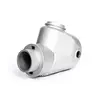Mobile:+86-311-808-126-83
Email:info@ydcastings.com
Techniques and Tips for Effective Casting in Sand Mold Preparation
The Art of Casting Sand A Timeless Craft
Casting sand, a process as ancient as civilization itself, has played a pivotal role in the creation of various metalworks and sculptures throughout history. This technique, often referred to as sand casting, involves using sand as a mold for shaping molten metal into desired forms. The enduring nature of this method, coupled with its versatility, makes it an intriguing subject to explore.
At its core, sand casting is not just a manufacturing process; it is an art form that combines science, skill, and creativity. The procedure begins with the creation of a sand mold, which is typically composed of a mixture of silica sand, clay, and water. This mixture allows the sand to retain its shape when compacted. Artisans and engineers take great care in designing the mold, making sure to account for the intricacies of the intended final product.
Once the mold is crafted, the next step involves heating metal until it reaches a liquid state. The material used can vary widely, including iron, aluminum, brass, and other alloys, each bringing its unique properties to the final piece. After the metal is melted, it is carefully poured into the prepped sand mold. This stage requires precision and timing, as the molten metal must be handled with care to avoid defects and ensure an even fill of the mold cavities.
As the metal cools, it solidifies, taking on the shape of the mold. After sufficient cooling time, the mold is broken away to reveal the newly formed object. This delicate process has the potential to yield error, making the skill of the craftsman indispensable. Small variations in temperature, sand composition, or mold design can lead to imperfections or even failures in the final product. Thus, years of experience and a meticulous approach are crucial for those who wish to master sand casting.
casting sand

Beyond its technical aspects, casting sand embodies a rich history. The earliest known evidence of sand casting dates back to around 3000 B.C. in ancient Egypt, where craftsmen created intricate metal tools and jewelry. Over millennia, different cultures have adopted and adapted this technique, leading to a global array of artistic and functional metalworks. From the ornate sculptures of the Renaissance to the practical components of modern industry, sand casting has evolved yet remains grounded in its historical roots.
In contemporary times, sand casting is prevalent in various industries, including automotive, aerospace, and art. Modern advancements have improved the efficiency and accuracy of the process, with technologies such as computer-aided design (CAD) and 3D printing influencing mold creation. These innovations allow for greater complexity in designs and reduce turnaround times, making sand casting a viable option for both prototypes and mass production.
Additionally, there is a growing appreciation for the artistic side of sand casting in the realm of sculpture and design. Artists are harnessing this time-honored technique to create unique and personal works that resonate with viewers on a deeper level. The tactile nature of sand-cast pieces, coupled with their rich textures and finishes, gives them a distinctive character that sets them apart from mass-produced items.
In conclusion, casting sand is more than just a method of manufacturing; it is a blend of art, history, and technology. As both craftsmen and artists continue to explore its possibilities, the process remains a vital component of creative expression and industrial innovation. Whether through the creation of functional objects or stunning sculptures, the legacy of sand casting endures, connecting modern artisans to their ancient counterparts in a continuous thread of human ingenuity.
-
Why Should You Invest in Superior Pump Castings for Your Equipment?NewsJun.09,2025
-
Unlock Performance Potential with Stainless Impellers and Aluminum End CapsNewsJun.09,2025
-
Revolutionize Your Machinery with Superior Cast Iron and Aluminum ComponentsNewsJun.09,2025
-
Revolutionize Fluid Dynamics with Premium Pump ComponentsNewsJun.09,2025
-
Optimizing Industrial Systems with Essential Valve ComponentsNewsJun.09,2025
-
Elevate Grid Efficiency with High-Precision Power CastingsNewsJun.09,2025











